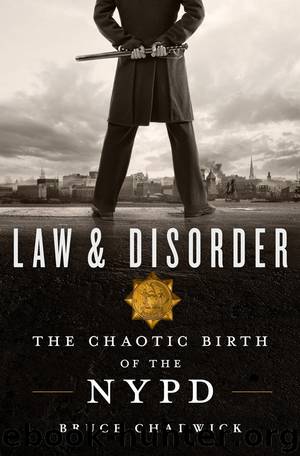Law & Disorder by Bruce Chadwick

Author:Bruce Chadwick
Language: eng
Format: epub
Publisher: St. Martin’s Press
CHAPTER TWELVE
Out with the Old, In with the New
The prevention of crime being the most important object in view, your exertions must be constantly used to accomplish that end. The absence of crime will be considered the best proof of the efficiency of the police.
—Judge Robert Taylor, Rules and Regulations for Day and Night Police of the City of New-York, 1848
New York City finally got its professional police force in 1845. That was the same year that a seaman on the Spencer, George Walling, with his mates, left the ship to help the New York City fire department and Brooklyn Navy Yard marines, and hundreds of New York residents, battle the Great Fire of 1845, the second worst in city history, which leveled dozens of blocks of stores and offices and destroyed hundreds of homes. Walling liked the city. A few months later, he ended his sailing career and moved to New York to work at a city produce market. In 1847, a friend of his retired from the police force and asked Walling if he would like to take his place. The ex-sailor did and, after an alderman approved, started walking a beat in the Third Ward a few months later. “I certainly never had the slightest idea of becoming a policeman,” he said, “but the proposition did not displease me. I had no particular business at the time and decided that I might as well carry a club until something better turned up.”1
Walling was there at the start, in a cold winter, as the brand-new, professional police force began. He would be a policeman for nearly forty years. He did everything from beating criminals with his nightstick to breaking up robbery rings to battling street gangs, river pirates, and the “butcher boys.” He worked as a patrolman, then a captain, then the chief of police. His memories make for a wonderful insider’s view of the crime wave that threatened to overwhelm New York City and the efforts of the first police force to maintain law and order in the teeming metropolis.
* * *
Many editors and civic reformers wanted the police force replaced with a professional squad not just because of the rising crime wave, but also because some members of the police force did really stupid things and were continually laughed at by the public. A perfect example is the midnight ride of Officer Thomas Doyle on July 24, 1843. The cop was riding his horse down Chatham Street, not paying any attention to where he was going. When he reached the intersection of Tryon Row, he and his steed tumbled down into an open construction pit. There were ropes and signs all around it to warn riders of its existence; Doyle said nothing was there. A disgruntled Doyle said his horse was worth eighty dollars and produced a witness, a friend, who said oh, no, it was worth a good hundred. Because the horse was injured, he had to sell it for just fifteen. Doyle said he lost a twenty-dollar harness in the tumble, too.
Download
This site does not store any files on its server. We only index and link to content provided by other sites. Please contact the content providers to delete copyright contents if any and email us, we'll remove relevant links or contents immediately.
Fanny Burney by Claire Harman(26254)
Empire of the Sikhs by Patwant Singh(22775)
Out of India by Michael Foss(16695)
Leonardo da Vinci by Walter Isaacson(12815)
Small Great Things by Jodi Picoult(6693)
The Six Wives Of Henry VIII (WOMEN IN HISTORY) by Fraser Antonia(5242)
The Wind in My Hair by Masih Alinejad(4852)
The Crown by Robert Lacey(4578)
The Lonely City by Olivia Laing(4576)
A Higher Loyalty: Truth, Lies, and Leadership by James Comey(4565)
The Iron Duke by The Iron Duke(4126)
Millionaire: The Philanderer, Gambler, and Duelist Who Invented Modern Finance by Janet Gleeson(4115)
Papillon (English) by Henri Charrière(3923)
Sticky Fingers by Joe Hagan(3916)
Joan of Arc by Mary Gordon(3796)
Alive: The Story of the Andes Survivors by Piers Paul Read(3743)
Stalin by Stephen Kotkin(3731)
Aleister Crowley: The Biography by Tobias Churton(3435)
Ants Among Elephants by Sujatha Gidla(3282)
